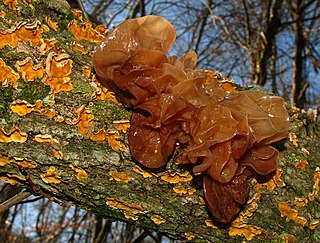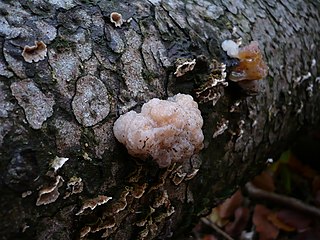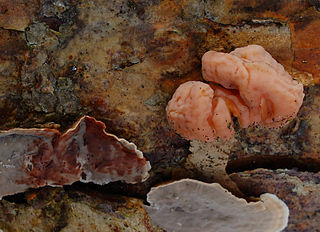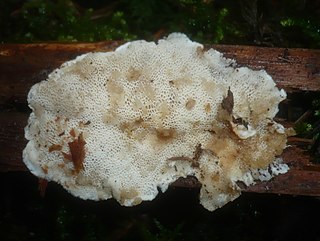
The Tremellaceae are a family of fungi in the order Tremellales. The family is cosmopolitan and contains both teleomorphic and anamorphic species, most of the latter being yeasts. All teleomorphs in the Tremellaceae are parasites of other fungi, though the yeast states are widespread and not restricted to hosts. Basidiocarps, when produced, are gelatinous.
The Cuniculitremaceae are a family of fungi in the order Tremellales. There are three genera in the family. Sterigmatosporidium polymorphum parasitizes other fungi growing in insect galleries in wood. It does not produce basidiocarps, but has septate basidia similar to those found in the genus Tremella. Most species are known only from their yeast states.

Tremella is a genus of fungi in the family Tremellaceae. All Tremella species are parasites of other fungi and most produce anamorphic yeast states. Basidiocarps, when produced, are gelatinous and are colloquially classed among the "jelly fungi". Over 100 species of Tremella are currently recognized worldwide. One species, Tremella fuciformis, is commercially cultivated for food.

Phaeotremella frondosa is a species of fungus in the family Phaeotremellaceae producing brownish, frondose, gelatinous basidiocarps. It is widespread in north temperate regions, and is parasitic on other species of fungi that grow on dead attached and recently fallen branches of broadleaf trees.

Phaeotremella foliacea is a species of fungus in the family Phaeotremellaceae. It produces brownish, frondose, gelatinous basidiocarps and is parasitic on the mycelium of Stereum sanguinolentum, a fungus that grows on dead attached and recently fallen branches of conifers. It is widespread in north temperate regions. In the UK it has the recommended English name leafy brain and has also been called jelly leaf and brown witch's butter. Prior to 2017, the name Tremella foliacea was also applied to similar-looking species on broadleaf trees, now distinguished as Phaeotremella frondosa and Phaeotremella fimbriata.
Cystofilobasidium is a genus of fungi in the family Cystofilobasidiaceae. Species occur as yeasts, but produce filamentous sexual states that form dikaryote teliospores, from which the unicellular basidia are formed. The hyphae usually have dolipore septa without a parenthesome, and their cell walls contain xylose. The genus currently contains nine species worldwide.

Naematelia is a genus of fungi in the family Naemateliaceae. All Naematelia species are parasites of other fungi and produce anamorphic yeast states. When produced, Basidiocarps ,, are gelatinous and are colloquially classed among the "jelly fungi."Four species of Naematelia are currently recognized worldwide. One species, Naematelia aurantialba, is commercially cultivated for food.

Naematelia aurantia is a species of fungus producing yellow, frondose, gelatinous basidiocarps. It is widespread in north temperate regions and is parasitic on another species of fungus that grows on dead attached and recently fallen branches of broadleaf trees. It is commonly called golden ear in North America.

Naematelia encephala is a species of fungus producing pink, brain-like, gelatinous basidiocarps. It is widespread in north temperate regions and is parasitic on another species of fungus that grows on dead attached and recently fallen branches of conifers. In the UK, its recommended English name is conifer brain.
Pseudotremella is a genus of fungi in the family Bulleraceae. All Pseudotremella species are parasites of other fungi and produce anamorphic yeast states. Basidiocarps, when produced, are gelatinous and are colloquially classed among the "jelly fungi". Four species of Pseudotremella are currently recognized worldwide. Two of these species are, as yet, only known from their yeast states.
The Bulleraceae are a family of fungi in the order Tremellales. The family currently contains five genera. Some species produce gelatinous basidiocarps and were formerly placed in the genus Tremella. Most, however, are only known from their yeast states.
Solicoccozyma is a genus of fungi in the family Piskurozymaceae. Species have only been isolated in their yeast states, several of which were formerly referred to the genus Cryptococcus, but can produce filamentous states with basidia in culture. Nine species have been described worldwide.
Cystobasidium is a genus of fungi in the order Cystobasidiales. The type species is a fungal parasite forming small gelatinous basidiocarps on various ascomycetous fungi on dung. Microscopically, it has auricularioid basidia producing basidiospores that germinate by budding off yeast cells. Other species are known only from their yeast states. The yeasts Cystobasidium minutum and C. calyptogenae are rare but known human pathogens.
Cystobasidium fimetarium is a species of fungus in the order Cystobasidiales. It is a fungal parasite forming small gelatinous basidiocarps on various ascomycetous fungi on dung. Microscopically, it has auricularioid basidia producing basidiospores that germinate by budding off yeast cells. The species is known from Europe and North America.

Carcinomyces polyporinus is a species of fungus in the class Tremellomycetes. It is a parasite, growing in the hymenia of various poroid fungi, particularly species of Postia. Microscopically, it resembles a species of Tremella, but DNA research indicates that it belongs in a different family, the Carcinomycetaceae. It was first described by British mycologist Derek Reid from Scotland. It has also been recorded in continental Europe and North America.

Sirobasidium brefeldianum is a species of fungus in the order Tremellales. Basidiocarps are gelatinous and appear to be parasitic on ascomycetous fungi on wood. The species was originally described from Brazil, but has also been reported from Asia and Europe.
Phaeotremella fimbriata is a species of fungus in the family Phaeotremellaceae. It produces blackish, frondose, gelatinous basidiocarps and is parasitic on the mycelium of Stereum rugosum, a fungus that grows on dead attached and recently fallen branches of broad-leaved trees. It is widespread in northern Europe. Prior to 2017, the species was generally considered a synonym of Tremella foliacea, but this latter species is restricted to conifers. Phaeotremella frondosa is a similar-looking but paler, brown species on broad-leaved trees and occurs in North America as well as Europe.
Phaeotremella roseotincta is a species of fungus in the family Phaeotremellaceae. It produces pinkish to pale pinkish brown, frondose, gelatinous basidiocarps and grows on dead attached and recently fallen branches of broad-leaved trees. It was originally described from Japan and has also been recorded from far eastern Russia.
Tremella yokohamensis is a species of fungus in the family Tremellaceae. It produces white, foliaceous, gelatinous basidiocarps and is parasitic on other fungi on dead wood of broad-leaved trees. It was originally described from Japan.
Phaeotremella translucens is a species of fungus in the family Phaeotremellaceae. It produces small, pustular, gelatinous basidiocarps and is parasitic on ascocarps of Lophodermium species on decaying pine needles. It was originally described from Scotland.











